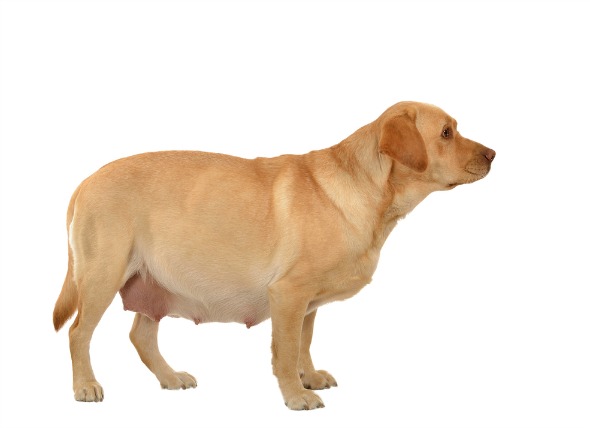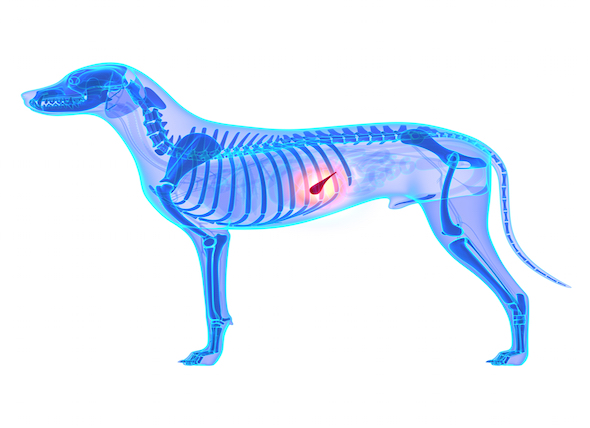

Peritonitis is often associated with acute abdominal pain due to the sudden inflammation of the abdominal tissues, or peritoneum, hence the name for the condition. This causes fluid to shift into the peritoneal cavity, leading to severe dehydration and electrolyte imbalance. Peritonitis may be due to infectious causes such as the stomach flu or non-infectious causes such as a hernia.
While younger dogs tend to have acute abdomen due to infectious and traumatic causes, malignant cancers are more often the cause of acute abdomen in older dogs. It is crucial to determine the underlying cause of the acute abdomen as your veterinarian may have to perform emergency surgery to resolve it.
Infectious Causes
Non-infectious Causes
Your veterinarian will need a complete medical history to begin to identify what is causing the acute abdomen. The history you provide may give your veterinarian clues as to which organs are causing the sudden abdominal pain. He or she will also perform a complete physical examination to see if the pain is really in the abdomen and not the kidneys or back. If your dog has a swollen abdomen, your veterinarian will use a fine needle to withdraw some of the fluid from the abdomen to send to the laboratory for analysis.
A complete blood profile will be conducted, including a chemical blood profile, a complete blood count, an electrolyte panel and a urinalysis. Your veterinarian may also use a syringe to take urine from your dog to be sent to a lab for examination.
Your veterinarian will need to use visual diagnostics to examine the abdomen internally. X-rays and ultrasound will be used to locate the source of the disturbance in the abdomen. If your dog is young (still a puppy) a parvovirus blood test may also be given.
The course of treatment will depend on the diagnosis. However, surgery is often necessary. Intravenous fluid therapy is usually required, as animals with acute abdomen are usually dehydrated, and this can quickly become a life threatening condition. Pain medication may be prescribed as well, to give your dog some relief.
Medicines can be used to decrease stomach acids and coat the stomach, depending on the cause of the disease. Likewise, if the disease so indicates, your dog may be given medicine to stop the vomiting and antibiotics to inhibit bacterial infection.
Acute abdomen is generally an indicator of a serious disease requiring intensive care under the supervision of a veterinarian. Several days of care are typical; in some cases, an animal may have to remain in ICU (intensive care unit) for prolonged periods.
After taking your dog home, give all of the prescribed medications exactly as your veterinarian instructs, for the entire amount of time that has been prescribed, even after the symptoms have passed and your dog appears to have fully recovered. Observe your dog closely for any changes. If you see swelling, pus, or if you have questions, call your doctor immediately, as this can turn into a life threatening condition quickly.
Follow-up appointments with your veterinarian are essential to assure that your dog's condition is improving.
 Coral Snake Bite Poisoning in Dogs
Coral Snake Venom Toxicosis in Dogs
There are two
Coral Snake Bite Poisoning in Dogs
Coral Snake Venom Toxicosis in Dogs
There are two
 Birth Difficulties in Dogs
Dystocia in Dogs
Dystocia is the medical term use
Birth Difficulties in Dogs
Dystocia in Dogs
Dystocia is the medical term use
 Mammary Gland Tumor in Dogs
Benign and malignant tumors of the mammary glands
Mammary Gland Tumor in Dogs
Benign and malignant tumors of the mammary glands
 Inflammation of the Pancreas in Dogs
Pancreatitis in Dogs
The pancreas is part of the
Inflammation of the Pancreas in Dogs
Pancreatitis in Dogs
The pancreas is part of the
 Paralysis in Dogs
Loss of Body Movement in Dogs
A dog’s abili
Paralysis in Dogs
Loss of Body Movement in Dogs
A dog’s abili
Copyright © 2005-2016 Pet Information All Rights Reserved
Contact us: www162date@outlook.com